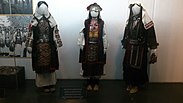
Back Serbios de Bosnia y Herzegovina AN صرب البوسنة والهرسك Arabic Сербы ў Босніі і Герцагавіне Byelorussian Srbi u Bosni i Hercegovini BS Serbis de Bòsnia i Hercegovina Catalan Srbové v Bosně a Hercegovině Czech Serbobosnios Spanish Bosnia ja Hertsegoviina serblased Estonian Serbes de Bosnie French Srbi Bosne i Hercegovine Croatian
 Flag of Republika Srpska | |
Serbian traditional clothing from (clockwise from top):
| |
| Total population | |
|---|---|
| 1,086,733 (2013)[1] | |
| Regions with significant populations | |
| Republika Srpska | 1,001,299 (92.13%) |
| Federation of BiH | 56,550 (5.20%) |
| Brčko District | 28,884 (34.58%) |
| Languages | |
| Serbian | |
| Religion | |
| Serbian Orthodox Church | |
| Part of a series on |
| Serbs |
|---|
 |
The Serbs of Bosnia and Herzegovina (Serbian Cyrillic: Срби Босне и Херцеговине, romanized: Srbi Bosne i Hercegovine), often referred to as Bosnian Serbs (Serbian Cyrillic: босански Срби, romanized: bosanski Srbi) or Herzegovinian Serbs (Serbian Cyrillic: херцеговачких Срби, romanized: hercegovačkih Srbi), are native and one of the three constituent nations of the country, predominantly residing in the political-territorial entity of Republika Srpska. Most declare themselves Orthodox Christians and speakers of the Serbian language.
Serbs have a long and continuous history of inhabiting the present-day territory of Bosnia and Herzegovina, and a long history of statehood in this territory. Slavs settled the Balkans in the 7th century and the Serbs were one of the main tribes who settled the peninsula including parts of modern-day Herzegovina. Parts of Bosnia were ruled by the Serbian prince Časlav in the 10th century before his death in 960. The territories of Duklja, including Zeta and Zachlumia were later consolidated into a Serbian Kingdom before its fall in 1101. In the second half of the 12th century, Bosnia and Herzegovina was ruled by the Nemanjić dynasty. Stephen Tomašević ruled briefly as Despot of Serbia in 1459 and as King of Bosnia between 1461 and 1463.
From the 15th century, Ottoman rule brought discrimination against the Orthodox population living in Bosnia and Herzegovina under the millet system but also a Serb national consciousness by the 19th century. The 20th century was marked by persecution from Austro-Hungarian occupation (1878–1918), WWII genocide, and eventual breakup of Yugoslavia leading to the Bosnian War in 1992. In the 1990s, many Serbs moved to Serbia proper and Montenegro.
Having lived in much of Bosnia-Herzegovina prior to the Bosnian War, the majority of the Serbs now live in Republika Srpska. According to the report by the Bosnia and Herzegovina statistics office, on the census of 2013 there were 1,086,733 Serbs living in Bosnia and Herzegovina.[1] In the Federation of Bosnia and Herzegovina, Serbs form the majority in Drvar, Glamoč, Bosansko Grahovo and Bosanski Petrovac. At the federal level, Serbs are represented by members in the Parliamentary Assembly of Bosnia and Herzegovina while on the state level, Republika Srpska has its own people's assembly. The Serbs of Bosnia and Herzegovina have made significant contributions to the culture of Bosnia and Herzegovina.
- ^ a b Sarajevo, juni 2016. CENZUS OF POPULATION, HOUSEHOLDS AND DWELLINGS IN BOSNIA AND HERZEGOVINA, 2013 FINAL RESULTS (PDF). BHAS. Archived (PDF) from the original on 29 September 2018. Retrieved 30 June 2016.





